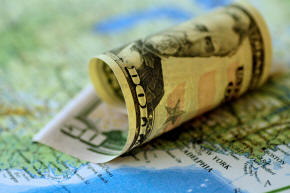|
The greenback is now at a 20-year high against other world
currencies, thanks in part to expectations that the Federal
Reserve will increase its interest rates faster than most.
Here are 10 reasons why you should be paying attention:
AMERICAN ABROAD A strong dollar is great if you are a U.S.
tourist. Hotels, meals or a designer bag all are cheaper by
comparison, whether in London, the French Riviera or Cancun. It
goes without saying that the reverse is true for the traveller
going to the United States unless they bought their Disneyland
tickets or Las Vegas junket a good while ago, it is going to
cost more.
THE JOYS OF PARITY - This is a welcome added boon for Americans
travelling to one of the 19 countries that use the euro and a
small consolation for European tourists in the United States. No
more mental arithmetic is required to convert between dollars
and euros you can call it pretty much one for one now.
MADE IN AMERICA For shoppers around the world in search of top
U.S. brands, the strong dollar means they could end up paying a
premium for them unless local distributors try to cushion the
currency impact. Just in the past days, U.S. companies such as
Mattel Inc maker of the Barbie doll and Hot Wheels cars said
it was seeing a hit from the dollars move upwards, even if
consumers as a whole looked ready to take on higher prices. For
consumer goods giant Procter & Gamble maker of everyday
products such as Pampers or Ariel the dollar's rise has always
tended to have a similar impact on its sales.
EMERGING TROUBLE - For Argentines, the rise of the dollar
against the peso has meant a doubling of local prices in just
one year and a spiralling economic crisis. Governments and
businesses in a lot of emerging economies finance themselves by
issuing bonds in U.S. dollars. The amount they owe has now
surged in value when measured in their local currency. Tapping
the market for more credit has also become more expensive
because U.S. rates have risen.
RAW MATERIALS - Countries like Turkey and Egypt that import a
lot of their raw materials have been hit by a double whammy.
Most commodities from oil to wheat are priced in U.S. dollars,
meaning they are paying more in their local currency for every
barrel or bushel they buy. This comes as the price of many of
those materials is already at a multi-year high due to the war
in Ukraine, extreme weather and the aftershock of the COVID
pandemic.
HOME SUPPORT - A strong dollar is good news for people in poorer
countries such as Mexico and Guatemala who depend on money sent
by relatives who work in the United States. The COVID-19 fallout
dealt a sharp blow to these remittances in 2020 but they've seen
a steady recovery since.
INFLATION - Even for richer countries such as Germany a strong
dollar can spell trouble because it helps fuel already
record-high inflation through more expensive imports. Local
central banks have generally responded by raising interest
rates, which makes credit dearer and slows economic growth.
ROUBLE RALLY - The Russian rouble is the only currency in the
world that is comfortably in the black against the dollar this
year - an unexpected outcome for a country under international
sanctions over its invasion of Ukraine. But this strength - a
somewhat artificial result of controls on foreign exchange -
does little for the ordinary Russian. Moscow may be raking in
tens of billions of dollars every month from its energy sales to
the West, but Russian households still can't withdraw their
foreign-currency savings. And Many Western brands from Adidas to
H&M and Ikea have stopped selling in Russia since the war
started.
BITCOIN - Marketed as the ultimate shield against inflation, the
world's largest crypto currency hasn't lived up to its promise
and is down by more than half this year despite runaway consumer
prices in large parts of the world. Legions of individual
investors drawn to crypto during last year's bull market have
now ditched the digital tokens to park their savings in a U.S.
currency they perceive as safer - and which is now starting to
pay interest again.
BEEF UP - If the price of a hamburger is anything to go by, the
dollar might actually be too strong and bound to fall back. The
Economist's Big Mac Index, which compares the price of the
ubiquitous burger around the world, shows that the greenback is
overvalued against all but a handful of currencies. The dollar
is most expensive - and a Big Mac cheapest for a U.S. traveller
- in Venezuela, Romania and Indonesia. The opposite is true in
Switzerland, Norway and Uruguay.
(Reporting by Francesco Canepa, Mark John, Elizabeth Howcroft,
Marc Jones and Karin Strohecker; Editing by Alison Williams)
[© 2022 Thomson Reuters. All rights
reserved.]
Copyright 2022 Reuters. All rights reserved. This material may not be published,
broadcast, rewritten or redistributed.
Thompson Reuters is solely responsible for this content.

|
|





